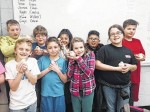Thomas Gallatin Apr. 5, 2017
The Washington Post recently ran a story with the provocative headline, GOP lawmaker: The Bible says the unemployed shall not eat. The article referenced comments made during a House Agriculture Committee hearing over the Supplemental Nutrition Assistance Program (SNAP) a.k.a. food stamps. The original version of the article at least acknowledged that Rep. Jodey Arrington (R-TX) cited 2 Thessalonians 3:10 in a rebuttal to an expert witness a representative from the Jewish anti-hunger group MAZON, who made reference to a passage in Leviticus about feeding the hungry.
Yet the Washington Post didnt actually quote Arrington in its rush to indict and label him and Republicans as uncaring and out of touch with the needs of the poor at least not until later revisions were made. The article states, House Republicans have historically cited the verse if a man will not work, he shall not eat as justification for cutting some adults' SNAP benefits. Arrington referenced the verse in a discussion about increasing the work requirements for unemployed adults on the food stamp program. But critics say that advances a pernicious myth about the unemployed who receive SNAP.
The truth is it was the Washington Post that was actively attempting to advance a pernicious myth regarding both the intent and reasoning of Republicans and Rep. Arrington specifically. And they were exposed for it.
Shortly after the articles release, The Federalists Sean Davis called out the Beltway rag over its sloppy and biased reporting. Davis pointed out that the Post failed to quote Arrington and failed to properly apply the Biblical context of both Scripture references.
The Washington Post, evidently catching wind of criticism for its lackluster piece, responded by heavily editing the original article, including changing the headline to GOP lawmaker: The Bible says if a man will not work, he shall not eat, as well as adding Arringtons exact words.
Arrington said, I did hear, Mr. Protas [the MAZON representative], your opening remarks where you quoted Leviticus, I believe and I think thats a great reflection on the character of God and the compassion of Gods heart and how we ought to reflect that compassion in our lives. But theres also, you know, in the Scripture, tells us in 2 Thessalonians 3:10 he says, For even when we were with you we gave you this rule: If a man will not work, he shall not eat. And then he goes on to say, We hear that some among you are idle. I think that every American, Republican or Democrat, wants to help the neediest among us. And I think its a reasonable expectation that we have work requirements. I think that gives more credibility, quite frankly, to SNAP. Tell me, what is a reasonable and responsible work requirement as part of the SNAP program?
The Post truncates his last few sentences, but upon reading the updated and edited article, the papers dubious characterization of both Arrington and the Republicans loses credibility, showing more glaringly the articles original bias as being primarily an anti-Republican propaganda piece. So much for the Posts Democracy Dies in Darkness tripe.
This episode proves to highlight a couple of important points. First, the Post is as agenda-driven as ever. The leftist commitment of the paper is beyond question. There simply is no reasonable attempt at balanced reporting in the entire piece, even after the edits it was shamed into making.
Second, and far more important, the article exposed the fundamental disagreement between leftists and conservatives when it comes to understanding the role of government.
The U.S. has a long history arguing over the extent government should play in contributing to welfare. Historically, conservatives have long championed a limited government that allows taxpayers to keep more of their money so as to assist their needy family, friends and neighbors as they are able and see fit. Conservatives have correctly argued that massive government income redistribution programs create greater dependency and less individual responsibility. Often these welfare programs, no matter how well intentioned, prove to rob individuals of the needed motivation to work as they lose the initiative for self-reliance, one of the foundational keys to pursuing happiness.
Leftists, on the other hand, dont trust individuals to make wise enough decisions and see the federal governments role as primary in determining what is in the best interests of its citizens. Therefore, regarding problems like poverty, leftists see only a need for greater federal involvement, which of course translates into greater spending as well as loss of freedom. For leftists, statism is the only solution.
Arringtons statement and quotation of Scripture voiced a legitimate concern over the abuse of a system that provides food stamps designed as a safety net, not a free-for-all. The Bible does indeed place a high value on looking out for the needs of others, but it also spends a great amount of text on rebuking laziness, as well as condemning theft and deceit. Due to the propensity of mankind to act selfishly, individuals are often motivated by these base evil desires and take advantage of the generosity of others, be it the government or other individuals.
Essentially, the Washington Post condemns without offering any genuinely honest or thoughtful commentary over the realistic concerns voiced by conservatives regarding both the appropriate role of government and the attendant budgetary concerns. Nor does the Post even attempt to accurately portray the various Biblical statements.
Its quite evident that the Post is content to misconstrue and grossly misinterpret Christian teaching in an effort to shame all Republicans for not supporting excessive government welfare programs.
At the Washington Post, it is truth, not democracy, that is dying in darkness.
Excerpt from:
Culture, Science & Faith Anatomy of a Smear Piece - Patriot Post
